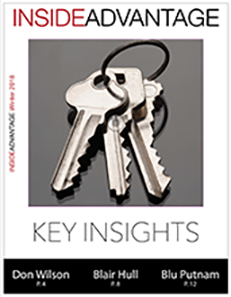Trader Trait #7: Becoming Trapped By 20/20 Hindsight
If we can see bubbles, meltdowns and similar major market events with such clarity in hindsight, why is it so hard to see them coming? For example, why did so many in our profession purchase prohibitively expensive homes, when the bulk of historical data indicated the prices were almost certainly unsustainable (as they indeed turned out to be)?
In investing (and sometimes in our trading careers), our best defense against misleading instincts is to rely on a different set of blinders: the kind that help us ignore getting trapped by predictions or reacting to 20/20 hindsight after it’s too late to do anything about it. These are the blinders of deliberate planning with a long-term goal as our guide. As President John F. Kennedy once said, “The time to repair the roof is when the sun is shining.”
Trader Trait #8: Mental Accounting On “House Money”
Behavioral finance has identified any number of ways we perform mental accounting on our assets, some of which make more sense than others. One mental accounting trick prevalent among traders (and many others) is thinking of our gains, or “house money,” as somehow not as real or valuable as our basis.
It’s the same at a Vegas craps table, where the player is eager to risk both his initial stake as well as his winnings on the next bet, instead of pocketing a portion in reserve. It’s also the same, albeit considerably more dangerous, when we play the house-money game with our entire personal portfolio.
Imagine that you’ve built your investment portfolio from $2 million to $3 million. Through financial planning, you determine the appreciated value should be enough to sustain your existing lifestyle indefinitely if need be. In the meantime, you continue with your trading career, where you are willing and able to take on high-volatility, leveraged risks, hoping to continue contributing earned income to your personal worth.
As you take on additional risks with your trading accounts, you have two important ways to manage that risk. Recalling that sound investment strategy is related to your willingness, ability and need to take on risk, you can:
- Continue to diligently direct a significant portion of any trading “wins” onward into your durable wealth — removing them from the proverbial table represented by your trading account. Offsetting the many risks taken during trading with an appropriately conservative investment portfolio (“conservative” as determined by your needs, anyway) is another form of diversification.
- Once your personal portfolio is well-positioned to support your desired lifestyle, consider reducing the risk exposures within it, especially if you continue to expose your professional assets to risk. This will decelerate the expected growth within your portfolio, but it also ensures you’re not sustaining a level of risk exposure for your personal wealth that is no longer aligned with your goals. In so doing, you’ll reduce unnecessary ground lost and improve on your peace of mind when the markets hit their inevitable rough spots.
Trader Trait #9: Assuming That “Familiar” Means “Safe”
In our profession, when there’s a history of certain trading methods and strategies working well over time, it’s natural to assume that they will continue to work well indefinitely. Unfortunately, reality has a way of periodically interfering with even our most venerable rules of thumb. We need only turn to some of the events of 2008 — such as the Federal Reserve stepping in to cover impending bank failure or the downfall of Auction Rate Securities — to recognize that even the most infallible assumptions can chart unfamiliar territories faster than a Lake Michigan undertow can knock you off your feet.

In our profession, we may at least have the seasoned experience to know how to hold our ground when the tried and true slips out from under us. But the trait becomes particularly dangerous when we succumb to familiarity as a strategy for choosing particular stocks within our investment portfolio. Enron, MCI, Lehman Brothers … It doesn’t take more than a few glaring examples to demonstrate that “familiar” and “safe” are decidedly not one and the same.
Instead of trying to pick and choose investments based on familiarity, hot streaks, sampling, gambling with house money or similar efforts that are colored by behavioral biases, we would suggest that more safety is found in strict adherence to your familiar, well-reasoned plan. In particular, we advise you to build your investment plan to manage the factors you can control (such as personal goals and risk tolerances) and to minimize the ones that you can’t (such as near-term market movements).






